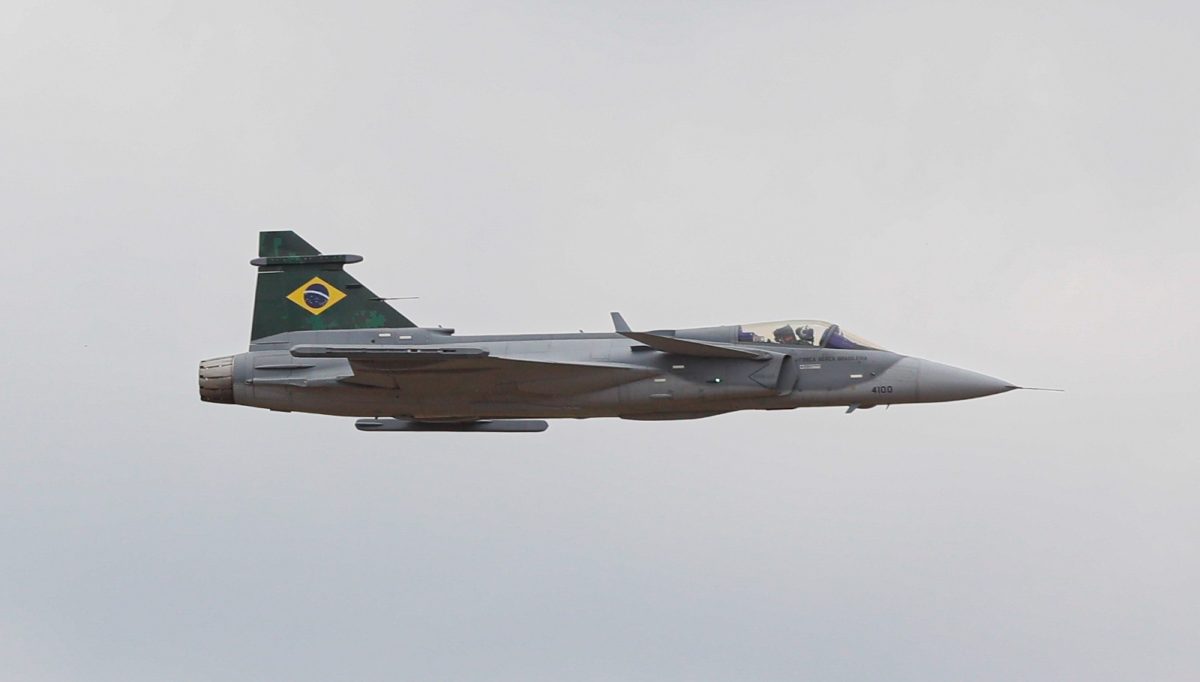With the Saab Gripen-E fighter jet’s resurgence in the international market, Brazil is poised to place another order for the Swedish aircraft.
The Swedish Ministry of Defence (MoD) said that Brazil is expected to add nine more Saab JAS 39 E/F Gripens to its 2014 order of 36 multi-role fighters. A letter of intent (LoI) to “expand their cooperation in the aerospace area” was signed by Swedish Defense Minister Pål Jonson and Brazilian Defense Minister José Múcio on November 9.
The letter revealed Sweden’s intention to buy an undisclosed number of Embraer C-390 Millennium tanker/transport aircraft and Brazil’s intention to add more Gripens to its existing fleet.
The Swedish statement read: “Brazil has now stated that it plans to increase the current contract for JAS 39 Gripen aircraft by 25%.” According to reports, Embraer will reportedly assemble the final 15 Gripens of the total purchased in Gavião Peixoto.
However, signing the LoI does not automatically translate into a purchase. Saab told Janes on 12 November: “We welcome the news, which is positive for Saab and Sweden. We know that Brazil is very pleased with Gripen as a fighter, and we look forward to continuing our discussions with Brazil regarding future orders. However, it is important to emphasize that no new contract has been signed yet, and we will not speculate about the content of a potential future contract.”
Brazil became the first customer of the Gripen-E fighter in 2014 when it placed an order for 36 Gripen-E jets. The South American country was the only aircraft customer for a decade until the Royal Thailand Air Force (RTAF) announced its decision to purchase the Gripen-E earlier this year. So far, eight of the 36 Gripen-E fighters ordered by Brazil have been delivered to the country and are operated by the 1º Grupo de Defesa Aérea at Anápolis Air Base, near Brasília.
Earlier this month, the Brazilian Gripens debuted at CRUZEX 2024, the largest multinational operational training exercise in Latin America, organized by the Brazilian Air Force.
At the time, the service announced that the F-39E Gripen, the most sophisticated fighter currently in service in Latin America, would carry out a variety of missions in Composite Air Operations (COMAO), a strategy in which several aircraft with various missions collaborate to overwhelm an adversary’s defenses. The exercise is scheduled to conclude on November 15.

Micael Johansson, President and CEO of Saab, said, “It is a true honor to see Gripen E’s debut at CRUZEX. We have eagerly awaited this moment marking Gripen E’s first participation in a multinational military exercise. We are delighted that this impressive inaugural event is hosted by our valued customer and partner, the Brazilian Air Force.”
The Brazilian decision to buy additional Gripen-E fighters follows reports in the Swedish media that another Latin American country, Colombia, has decided to purchase a fleet of JAS Gripen fighter aircraft manufactured by Saab. As reported by EurAsian Times, neither the Colombian government nor Saab confirmed the reports.
Clearing the air later, Colombia’s Defence Minister Ivan Velasquez said at a press conference, “There’s still nothing definitive. There are many rumors and no statement from the government.”
Despite this, Colombia’s interest in the aircraft suggested that it is likely back in the reckoning after a lull of over a decade when it faced many setbacks in the export market.
Earlier this year, Hungary hinted at placing an order for Gripen-E jets, whereas Thailand announced that it had selected the Gripen-E over the US F-16 Block 72 aircraft. Saab has also offered the aircraft to the Philippines, where it remains optimistic of a deal.
In Latin America, Peru has also confirmed that it is evaluating the fighter jets on offer, including the Lockheed Martin F-16 and Dassault Rafale. The Brazilian announcement may further boost the aircraft’s export potential, especially in Latin America.
Saab’s Gripen-E
Although the single-seat E-model’s outward design is largely similar to its predecessors, it offers several notable improvements and distinctions.
Saab describes the Gripen-E as “Designed to defeat any adversary. Made for forward-thinking air forces, Gripen E incorporates cutting-edge technologies, the latest systems, sensors, weapons, and pods to ensure combat advantage, delivering air superiority in highly contested environments. Silent networking and total sensor fusion across a tactical air unit to blind and confuse the enemy.”
According to Saab, the Gripen-E’s ability to launch the first missile and land the first kill could alter the nature of combat. Saab asserts that their architecture is revolutionary because it can quickly incorporate new hardware and update software to meet changing mission requirements. Moreover, the Gripen is designed for quick field deployment, especially at remote bases, and only a few people are required for its maintenance.
The fighter jet has an upgraded General Electric F414-GE-39E engine, more visible air intakes, and ten hardpoints on the airframe that carry weaponry, ammunition, and support equipment like flares and countermeasures, targeting pods, or drop tanks. More importantly, the Gripen-E can also carry the lethal, beyond-visual-range air-to-air Meteor missile. Gripen E can carry seven of them simultaneously.
Stealth design features are not present in the Gripen-E. Saab contends that this decision was made due to the rapid advancement of software and hardware technologies, which it believes will improve stealth aircraft radar detection. Saab has decided to remain competitive by relying on quickly evolving technology rather than stealth to gain an advantage in combat.
Gripen-E also features highly sophisticated electronic warfare and communication systems, a new active electronically scanned array (AESA) radar, and the InfraRed Search and Track System (IRST). Saab says, “The E-series redefines air power for the 21st century by extending operational capabilities.”
Moreover, the aircraft is a cost-effective alternative to its rivals, especially for countries that are not looking to spend big money on expensive fighter jets like Lockheed Martin’s F-35 Lightning II.
- Contact the author at sakshi.tiwari9555 (at) gmail.com
- Follow EurAsian Times on Google News




